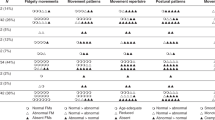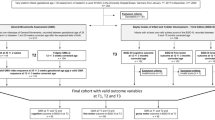Abstract
Objective:
To determine whether a Bayley-III motor composite score of 85 may overestimate moderate–severe motor impairment by analyzing Bayley-III motor components and developing cut-point scores for each.
Study Design:
Retrospective study of 1183 children born <27 weeks gestation at NICHD Neonatal Research Network centers and evaluated at 18–22 months corrected age. Gross Motor Function Classification System determined gross motor impairment. Statistical analyses included linear and logistic regression and sensitivity/specificity.
Results:
Bayley-III motor composite scores were strong indicators of gross/fine motor impairment. A motor composite cut-point of 73 markedly improved the specificity for identifying gross and/or fine motor impairment (94% compared with a specificity of 76% for the proposed new cut-point of 85). A Fine Motor Scaled Score <3 differentiated mild from moderate–severe fine motor impairment.
Conclusions:
This study indicates that a Bayley-III motor composite score of 85 may overestimate impairment. Further studies are needed employing term controls and longer follow-up.
This is a preview of subscription content, access via your institution
Access options
Subscribe to this journal
Receive 12 print issues and online access
$259.00 per year
only $21.58 per issue
Buy this article
- Purchase on Springer Link
- Instant access to full article PDF
Prices may be subject to local taxes which are calculated during checkout

Similar content being viewed by others
References
Bayley N . Bayley Scales of Infant Development, 2nd Edition. The Psychological Corporation: San Antonio, 1993.
Bayley N . Bayley Scales of Infant and Toddler Development, 3rd Edition (BSIDIII): Technical Manual Harcourt Assessment/Psychological Corporation: San Antonio, 2006.
Palisano R, Rosenbaum P, Walter S, Russell D, Wood E, Galuppi B . Development and reliability of a system to classify gross motor function in children with cerebral palsy. Dev Med Child Neurol 1997; 39: 214–223.
Vohr BR, Stephens BE, Higgins RD, Bann CM, Hintz SR, Das A et alEunice Kennedy Shriver National Institute of Child Health and Human Development Neonatal Research Network. Are outcomes of extremely preterm infants improving? Impact of Bayley assessment on outcomes. J Pediatr 2012; 161: 222–228.
Anderson PJ, De Luca CR, Hutchinson E, Roberts G, Doyle LW . Victorian Infant Collaborative Group. Underestimation of developmental delay by the new Bayley-III Scale. Arch Pediatr Adolesc Med 2010; 164: 352–356.
Acton BV, Biggs WS, Creighton DE, Penner KA, Switzer HN, Thomas JH et al. Overestimating neurodevelopment using the Bayley-III after early complex cardiac surgery. Pediatrics 2011; 128: e794–e800.
Long SH, Galea MP, Eldridge BJ, Harris SR . Performance of 2-year-old children after early surgery for congenital heart disease on the Bayley Scales of Infant and Toddler Development, Third Edition Early Hum Dev 2012; 88: 603–607.
Skjöld B, Vollmer B, Böhm B, Halberg B, Horsch S, Mosskin M et al. Neonatal magnetic resonance imaging and outcome at age 30 months in extremely preterm infants. J Pediatr 2012; 160: 559–566 e1.
Moore T, Johnson S, Haider S, Hennessy E, Marlow N . Relationship between test scores using the second and third editions of the Bayley Scales in extremely preterm children. J Pediatr 2012; 160: 553–558.
Lowe JR, Erickson SJ, Schrader R, Duncan AF . Comparison of the Bayley II Mental Developmental Index and the Bayley III Cognitive Scale: are we measuring the same thing? Acta Paediatr 2012; 101: e55–e58.
Newman JE, Bann CM, Vohr BR, Dusick AM, Higgins RD Follow-Up Study Group of Eunice Kennedy Shriver National Institute of Child Health and Human Development Neonatal Research Network. Improving the Neonatal Research Network annual certification for neurologic examination of the 18-22 month child. J Pediatr 2012; 161: 1041–1046.
Bodkin A, Robinson C, Perales F . Reliability and Validity of the Gross Motor Function Classification System for Cerebral Palsy. Pediatr Phys Ther 2003; 15: 247–252.
Peralta-Carcelen M, Moses M, Adams-Chapman I, Gantz M, Vohr BR . Stability of neuromotor outcomes at 18 and 30 months of age after extremely low birth weight status. Pediatrics 2009; 123: e887–e895.
Pappas A, Kendrick DE, Shankaran S, Stoll BJ, Bell EF, Laptook AR et al. Chorioamnionitis and early childhood outcomes among extremely low gestational age neonates. JAMA Pediatr 2014; 168: 137–147.
Chapman-Adams I, Bann CM, Vaucher YE, Stoll BJ . Association between feeding difficulties and language delay in preterm infants using Bayley Scales of Infant Development-Third Edition. J Pediatr 2013; 163: 680–685.
Schmidt B, Anderson PJ, Doyle LW, Dewey D, Grunau RE, Asztalos EV et al. Survival without disability to age 5 years after neonatal caffeine therapy for apnea of prematurity. JAMA 2012; 307: 275–282.
Azzopardi DV, Strohm B, Edwards AD, Dyet L, Halliday HH, Juszczak E et al. Moderate hypothermia to treat perianal asphyxia encephalopathy. NEJM 2009; 361: 1349–1358.
Kim CT, Han J, Heakyung K . Pediatric stroke recovery: a descriptive analysis. Arch Phys Med Rehabil 2009; 90: 657–662.
Boyd LAC, Msall ME, O’Shea TM, Allred EN, Hounshell G, Leviton A . Social-emotional delays at 2 years in extremely low gestational age survivors: correlates of impaired orientation/engagement and emotional regulation. Early Hum Dev 2013; 89: 925–930.
WHO International Classification of Functioning, Disabilty and Health: Children & Youth Version (ICF-CY). Geneva: WHO, 2001.
Spittle AJ, Spencer-Smith MM, Eeles AL, Lee KJ, Lorefice LE, Anderson PJ et al. Does the Bayley-III Motor Scale at 2 years predict motor outcome at 4 years in very preterm children? Dev Med Child Neurol 2013; 55: 448–452.
Aylward GP . Continuing issues with the Bayley-III: where to go from here. J Dev Behav Pediatr 2013; 34: 697–701.
Bayley III . Technical Report 2: Factors contributing to differences between Bayley-III and BSID-II scores. Harcourt Assessment: San Antonio, 2007.
Hack M . Dilemmas in the measurement of developmental outcomes of preterm children. J Pediatr 2012; 160: 537–538.
Msall ME . Measuring outcomes after extreme prematurity with the Bayley-III Scales of infant and toddler development: a cautionary tale from Australia. Arch Pediatr Adolesc Med 2010; 164 (4): 391–393.
Msall ME . The Bayley-III scale underestimates developmental delay in extremely premature and extremely low birth weight infants. J Pediatr 2010; 157 (5): 863–864.
Msall ME . Overestimating neuroprotection in congenital heart disease: problems with Bayley III Outcomes. Pediatrics 2011; 128: e993–e994.
Aylward GP, Sylward BS . The changing yardstick in measurement of cognitive abilities in infancy. J Dev Behav Pediatr 2011; 32: 465–468.
Morris C, Kurinczuk JJ, Fitzpatrick R, Rosenbaum P . Reliability of the manual ability classification system for children with cerebral palsy. Dev Med Child Neurol 2006; 48: 950–953.
Beckung E, Hagberg G . Neuroimpairments, activity limitations, and participation restrictions in children with cerebral palsy. Dev Med Child Neurol 2002; 44: 309–316.
Plasschaert VFP, Ketelar M, Nijnuis MG, Enkelaar L, Gorter JW . Classification of manual abilities in children with cerebral palsy under 5 years of age: how reliable is the Manual Ability Classification System? Clin Rehab 2009; 23: 164–170.
Acknowledgements
The National Institutes of Health, the Eunice Kennedy Shriver National Institute of Child Health and Human Development (NICHD), the National Center for Research Resources and the National Center for Advancing Translational Sciences provided grant support for the Neonatal Research Network’s Generic Database and Follow-up Studies. The content of the publication is solely the responsibility of the authors and does not necessarily represent the official views of the National Institutes of Health.
Author information
Authors and Affiliations
Consortia
Corresponding author
Ethics declarations
Competing interests
The authors declare no conflict of interest.
Additional information
Supplementary Information accompanies the paper on the Journal of Perinatology website
Rights and permissions
About this article
Cite this article
Duncan, A., Bann, C., Boatman, C. et al. Do currently recommended Bayley-III cutoffs overestimate motor impairment in infants born <27 weeks gestation?. J Perinatol 35, 516–521 (2015). https://doi.org/10.1038/jp.2014.243
Received:
Revised:
Accepted:
Published:
Issue Date:
DOI: https://doi.org/10.1038/jp.2014.243
This article is cited by
-
Quality improvement project designed to reduce disproportionate growth in extremely low gestational age neonates: cognitive neurodevelopmental outcome at 18–41 months
Journal of Perinatology (2021)
-
Early developmental assessment with a short screening test, the STEP, predicts one-year outcomes
Journal of Perinatology (2019)
-
Severe intraventricular hemorrhage and withdrawal of support in preterm infants
Journal of Perinatology (2017)



